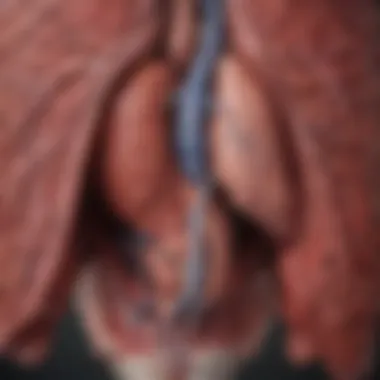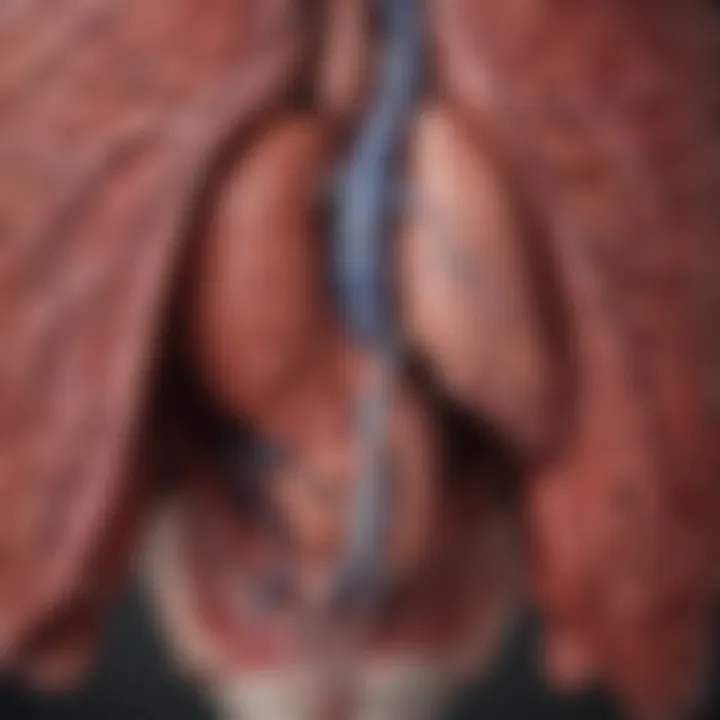Understanding GI Hepatology: An In-depth Exploration


Intro
Gastrointestinal hepatology remains a vital field within medical research and clinical practice. It examines liver conditions and their links to gastrointestinal health. Understanding this complex relationship is essential for developing effective diagnostic and treatment strategies. Often overlooked, the liver's role transcends beyond its traditional functions, influencing numerous physiological processes. This article endeavors to explore the nuances of GI hepatology while bridging fundamental concepts with real-world applications.
Recent Advances
Latest Discoveries
In recent years, significant developments have emerged in the study of liver diseases. Researchers are uncovering novel insights into conditions such as fatty liver disease, viral hepatitis, and cirrhosis. For instance, studies are revealing how the gut microbiome affects liver metabolism. This interplay contributes to a variety of diseases. By understanding these mechanisms, we can better tailor our therapeutic approaches. Moreover, recent genomic studies have identified specific biomarkers, which enhance our diagnostic capabilities.
Technological Innovations
Technological advancements also play a critical role in this field. Non-invasive imaging techniques, such as elastography and advanced MRI scans, allow more accurate assessments of liver stiffness and fat content. These tools have minimized the reliance on liver biopsies, making diagnosis safer and easier. Additionally, machine learning algorithms emerge in analyzing vast datasets to predict disease outcomes and treatment responses. These innovations enhance our ability to intervene early in liver diseases, thus improving patient management.
Methodology
Research Design
Research in GI hepatology often employs a variety of methodological approaches. Randomized controlled trials provide high-level evidence on the effectiveness of treatments. Observational studies, on the other hand, offer insights into real-world disease progression and patient outcomes. A mixed-methods approach, incorporating qualitative inputs, also enriches our understanding of patient experiences and barriers to treatment.
Data Collection Techniques
When studying liver conditions, researchers use diverse data collection techniques. Surveys and questionnaires assist in gathering patient-reported outcomes. Laboratory analysis enables the identification of biochemical markers. Additionally, advanced imaging and histological studies support detailed assessments of liver pathology. Consolidating data from these multiple sources provides a comprehensive picture of liver health and disease.
The complexity of GI hepatology requires a collaborative approach among researchers, clinicians, and healthcare providers. Through this partnership, we can enhance our understanding and management of liver diseases.
As this article unfolds, we will delve deeper into these themes. The objective is to elucidate the fundamental principles and advanced findings within GI hepatology.
Preamble to GI Hepatology
The realm of GI hepatology constitutes a significant intersection of gastrointestinal function and hepatic health. Understanding GI hepatology is vital for grasping how liver diseases can influence overall health and the complexities involved in treating such conditions. As the liver plays a central role in metabolism, detoxification, and immune regulation, its health directly impacts the functionality of the entire gastrointestinal system.
The nuances of GI hepatology include various aspects such as liver anatomy, pathophysiology of liver diseases, and innovative research in the field. Engaging with these elements not only uncovers the intricate connections between liver conditions and GI disorders but also emphasizes their implications for patient care and public health.
This article aims to illuminate these regions through a precise exploration of liver functions, common diseases, diagnostic approaches, and treatment modalities. Understanding GI hepatology equips students, researchers, educators, and medical professionals with essential knowledge that informs effective interventions and innovative practices in the field.
The Scope of GI Hepatology
GI hepatology encompasses several areas of interest, each contributing to a comprehensive understanding of liver and gastrointestinal function. Key areas include:
- Pathophysiology of liver diseases: Understanding how liver dysfunction leads to systemic consequences.
- Diagnostic techniques: Learning about imaging, blood tests, and liver biopsies that aid in diagnosis.
- Treatment strategies: Exploring both conventional and emerging therapeutic options for liver diseases.
- Research advancements: Staying informed about the latest findings in hepatology.
This diverse scope enriches the field, providing insights into how liver health is critical across various medical disciplines and enhancing interdisciplinary approaches to patient care.
The Importance of Hepatic Health
Hepatic health is crucial for maintaining overall bodily function. The liver regulates various biochemical processes essential for metabolism and detoxification. When the liver is compromised, the following can occur:
- Metabolic imbalance: Affecting energy levels, weight management, and other metabolic functions.
- Toxin accumulation: Risking the development of additional health problems due to inadequate detoxification.
- Infection susceptibility: Compromised liver function may weaken the immune system, increasing vulnerability to infections.
Preserving hepatic health should be viewed as a priority. Early detection of liver disease, understanding risk factors, and implementing lifestyle modifications can lead to better health outcomes. The commitment to studying GI hepatology is an investment in the health of the population, as it highlights the importance of liver health in preventing various diseases.
Anatomy of the Gastrointestinal Tract
The anatomy of the gastrointestinal (GI) tract is crucial to understanding the interactions and functions within the broader field of hepatology. The GI tract comprises a complex system that processes food and absorbs nutrients while facilitating the elimination of waste. The liver plays a significant role in this process, acting as a key organ for metabolism and detoxification. When exploring hepatology, one cannot overlook the interconnectedness of these systems. A thorough grasp of this anatomy aids in recognizing how liver function influences overall health and disease.
Overview of the Digestive System
The digestive system consists of several organs that work together to transform ingested food into essential nutrients. It starts at the mouth, where mechanical and chemical breakdown occurs. Saliva contains enzymes that begin the digestion of carbohydrates. From the mouth, food travels down the esophagus into the stomach. In the stomach, gastric juices further aid the breakdown of food into a semi-liquid state called chyme.
Following this, chyme enters the small intestine, where most nutrient absorption takes place. The small intestine is a highly specialized organ, with its inner lining covered in villi and microvilli that increase the surface area for absorption. This organ is also responsible for the mixing of chyme with bile from the liver and pancreatic juices.
The role of the large intestine follows, where water and electrolytes are reabsorbed, and indigestible remains are formed into feces. Understanding this sequential pathway highlights how nutrition and waste management are directly connected to liver function, making liver health paramount in the context of GI physiology.


Liver Function and Structure
The liver is arguably one of the most vital organs in the body. It performs a myriad of functions, including bile production, metabolism of nutrients, and detoxification of harmful substances. Structurally, the liver is divided into lobes that contain hepatocytes, the primary cells responsible for its diverse functions.
Hepatocytes engage in processes like glycogenesis, where glucose is stored as glycogen, and gluconeogenesis, which is the synthesis of glucose from non-carbohydrate sources. Furthermore, the liver is crucial in synthesizing proteins such as albumin and clotting factors, which are key for maintaining blood volume and coagulation.
"The liver’s regenerative capacity is remarkable, enabling it to recover from damage more than any other organ in the body."
Additionally, the liver plays a crucial role in the metabolism of drugs and alcohol. Its ability to conjugate substances with glucuronic acid or sulfate facilitates their excretion. Understanding the specifics of liver structure and function provides insights into how liver diseases may develop and influence the entire GI tract. Recognizing these anatomical and functional relationships is essential for both diagnostic and therapeutic developments in hepatology.
Common Liver Diseases
Understanding common liver diseases is vital for recognizing the impact of liver health on overall well-being. These diseases can lead to significant morbidity and mortality, thus emphasizing the need for education and awareness. The liver plays a crucial role in metabolism, detoxification, and protein synthesis. Therefore, addressing liver diseases can lead to better management of health issues and improved outcomes for patients.
Hepatitis: Types and Causes
Hepatitis signifies inflammation of the liver and can result from various factors. The major types of hepatitis include:
- Hepatitis A: Typically transmitted through contaminated food or water. It is usually a self-limited infection.
- Hepatitis B: Spread through blood and bodily fluids. This type can have both acute and chronic forms, potentially leading to serious complications.
- Hepatitis C: Mostly transmitted through blood. Chronic infection can develop, resulting in significant liver damage over time.
- Hepatitis D: This occurs only in those infected with hepatitis B. It complicates the disease progression.
- Hepatitis E: Transmitted primarily through fecal contamination of water sources.
Understanding these types helps identify effective prevention and treatment strategies.
Fatty Liver Disease: A Growing Concern
Fatty liver disease has emerged as a significant health issue worldwide. This condition is characterized by excessive fat accumulation in liver cells. There are two primary types:
- Alcoholic Fatty Liver Disease: Resulting from excessive alcohol consumption.
- Non-Alcoholic Fatty Liver Disease (NAFLD): Linked to obesity, diabetes, and metabolic syndrome. NAFLD can progress to non-alcoholic steatohepatitis (NASH), which can cause severe liver damage.
The rising prevalence of this disease calls for increased public awareness and appropriate lifestyle modifications to mitigate its progression.
Cirrhosis: Consequences and Complications
Cirrhosis represents the end-stage of liver disease, marked by extensive fibrosis and scarring. It results from various chronic liver conditions, including hepatitis and alcohol abuse. Complications of cirrhosis include:
- Portal Hypertension: Increased blood pressure in the veins that supply the liver.
- Liver Failure: The liver loses its ability to function properly.
- Liver Cancer: It's a well-known complication of chronic liver disease.
- Esophageal Varices: Dilated veins in the esophagus due to increased blood pressure.
Management of cirrhosis involves addressing the underlying causes and complications to improve patient quality of life.
Liver Cancer: Risk Factors and Symptoms
Liver cancer is a significant global health issue, with numerous risk factors influencing its onset. These include:
- Chronic Hepatitis B or C infections
- Cirrhosis
- Exposure to aflatoxins
- Excessive alcohol consumption
Common symptoms to watch for are:
- Unexplained weight loss
- Loss of appetite
- Upper abdominal pain
- Jaundice (yellowing of the skin and eyes)
Early detection is crucial for effective management and treatment options, underscoring the need for regular surveillance in high-risk individuals.
Understanding these diseases is essential for proactive health management and for reducing disease burden on individuals and society at large.
Diagnostic Approaches in GI Hepatology
The understanding of liver diseases necessitates precise diagnostic methods. Various approaches ensure that clinicians can identify and evaluate hepatic conditions effectively. In GI hepatology, diagnostic techniques can significantly influence treatment outcomes. Access to accurate data regarding liver health allows for tailored interventions. The integration of modern diagnostic methods further enhances the ability to diagnose liver ailments early, which is crucial for better management and potential reversibility of conditions.
Imaging Techniques: An Overview
Imaging techniques play a vital role in the diagnosis of liver diseases. Common modalities include ultrasound, computed tomography (CT), and magnetic resonance imaging (MRI). Each method has its specific utility:
- Ultrasound is often the first imaging test performed due to its non-invasive nature and cost-effectiveness. It can identify structural changes and help assess liver size and blood flow.
- CT scans provide detailed cross-sectional images, useful for detecting tumors or assessing liver lesions and their characteristics.
- MRI is particularly beneficial for characterizing liver lesions and evaluating conditions like fatty liver disease and cirrhosis more accurately.
These imaging techniques help in making informed decisions about further investigation or treatment.


Blood Tests and Biomarkers
Blood tests are essential for evaluating liver function. Common tests include liver function tests (LFTs), hepatitis serologies, and specific biomarkers.
- Liver function tests assess enzymes like alanine aminotransferase (ALT) and aspartate aminotransferase (AST), which indicate liver injury. Elevated results may signal inflammation or damage.
- Hepatitis serologies test for viral infections, crucial for diagnosing hepatitis A, B, and C. Identifying the virus is vital for determining the right management approach.
- Biomarkers such as alpha-fetoprotein (AFP) are significant in detecting liver cancer. Regular monitoring can aid early diagnosis, improving survival rates.
Understanding the blood test results allows healthcare providers to chart an appropriate course of action for each patient.
Liver Biopsy: Indications and Procedures
Liver biopsy remains a cornerstone in diagnosing liver diseases when non-invasive methods do not yield conclusive results. This procedure involves obtaining a small tissue sample from the liver for histopathological evaluation. It is typically indicated under the following circumstances:
- Unexplained liver disease: When imaging studies and blood tests do not provide a clear diagnosis.
- Assessing the severity of liver disease: Biopsy helps stage diseases like hepatitis or cirrhosis, providing insight into the degree of fibrosis or inflammation.
- Monitoring treatment response: In cases of chronic liver diseases, biopsies can help assess how well the patient responds to therapies.
The procedure is usually performed under ultrasound guidance to enhance safety and accuracy. Recovery typically involves monitoring for complications like bleeding or infection.
It's essential for clinicians to weigh the risks and benefits when considering a liver biopsy, ensuring it aligns with the patient's overall health strategy.
Treatment Modalities in Liver Diseases
Treatment modalities in liver diseases are essential to managing hepatic disorders effectively. These approaches often encompass a combination of pharmacological interventions, lifestyle modifications, and, when necessary, surgical procedures. Understanding these treatment modalities provides valuable insights into how healthcare professionals can tailor treatments to meet the specific needs of their patients while improving outcomes and quality of life. Each treatment option plays a significant role in addressing the diverse aspects of liver diseases.
Pharmacological Interventions
Pharmacological interventions for liver diseases focus on managing symptoms and slowing disease progression. Medications can range from antiviral drugs for hepatitis to drugs that manage complications of cirrhosis. Notable examples include Sofosbuvir and Ledipasvir for hepatitis C, which can significantly increase cure rates. These drugs act by targeting the viruses responsible for liver inflammation and damage.
Benefits of pharmacological treatments include:
- Reducing viral load in cases of viral hepatitis.
- Alleviating symptoms such as jaundice, itching, or abdominal pain.
- Preventing the progression of liver fibrosis to cirrhosis.
However, it is essential to consider potential side effects and contraindications. Healthcare providers must assess each patient’s history before prescribing medications to prevent adverse reactions. Ongoing monitoring of liver function tests is also crucial during treatment.
Lifestyle Modifications and Their Impact
Lifestyle modifications play a crucial role in managing liver health and enhancing the effectiveness of medical treatments. Simple changes can lead to substantial benefits, particularly for individuals with non-alcoholic fatty liver disease or those recovering from liver injury.
Important lifestyle modifications include:
- Dietary Changes: A balanced diet rich in fruits, vegetables, whole grains, and lean proteins supports liver function. Avoiding saturated fats, refined sugars, and excessive salt is important for reducing liver strain.
- Regular Exercise: Engaging in regular physical activity improves metabolism and helps maintain a healthy weight. Weight loss can significantly reduce liver fat in overweight individuals, positively impacting liver enzymes.
- Abstaining from Alcohol: Limiting or avoiding alcohol intake is critical to preventing further liver damage. Alcohol can exacerbate existing conditions and lead to more severe diseases, such as alcoholic hepatitis or cirrhosis.
A comprehensive approach that incorporates these lifestyle changes can lead to significant improvements in liver health, potentially reducing the need for more invasive treatments.
Surgical Considerations in Hepatology
In specific cases, surgical interventions may become necessary, especially in advanced liver disease. Surgical options vary widely based on the underlying condition, but they can be life-saving when appropriately indicated.
Common surgical considerations include:
- Liver Transplantation: This is often the last resort for patients with end-stage liver disease. It involves replacing a diseased liver with a healthy one from a donor, which can restore normal function.
- Biliary Surgery: Procedures may be needed to correct biliary obstructions, often caused by conditions like gallstones or tumors.
- Ablation and Resection: Tumors in the liver may require ablation techniques or surgical resection. These procedures can help eliminate cancerous cells or modify liver tissue for better function.
However, surgical options come with risks, including complications that depend on the patient’s overall health and the stage of liver disease. Close collaboration among hepatologists, surgeons, and other specialists is crucial for optimizing patient care.
Hepatology: A Multidisciplinary Approach
Hepatology, the study of the liver, is inherently complex. The importance of a multidisciplinary approach in this field cannot be overstated. This approach integrates various specialties, bringing together physicians, nutritionists, researchers, and other healthcare providers. Each professional contributes unique insights that enhance the understanding and treatment of liver diseases. Such collaboration ensures comprehensive patient care, leading to better health outcomes.
One significant aspect of this multidisciplinary approach is the sharing of knowledge and expertise. For instance, hepatologists may work closely with endocrinologists for patients with conditions like diabetes, as these can influence liver health. Additionally, a gastroenterologist's expertise is invaluable when addressing issues related to the gastrointestinal tract that may affect liver function. This continuum of care improves diagnostic accuracy and treatment efficacy.
The benefits of this collaborative model are substantial:
- Holistic Care: Patients receive a more thorough evaluation. Each specialty can assess how their field impacts liver health.
- Innovative Solutions: Different perspectives promote innovative therapies and research. It opens doors for new ideas and solutions to complex problems.
- Improved Communication: Working together fosters better communication between teams, ensuring a seamless patient experience.
- Education and Awareness: Sharing information enhances overall awareness about liver health among professionals and the public.
Thus, a multidisciplinary approach is not just beneficial; it is essential for advancing hepatology. By integrating varied expertise, we address the multifaceted nature of liver diseases.


Collaborative Care Models
Collaboration in hepatology often involves the establishment of care models that bring together various healthcare professionals. These models can range from interdisciplinary clinics, where multiple specialist teams provide care in one location, to integrated healthcare systems that facilitate communication among different departments.
In a collaborative care model, the patient's journey is streamlined. For example, patients might consult a hepatologist, a dietitian, and a social worker during a single visit. Each professional assesses the patient from their perspective and discusses findings with the team. This leads to a more unified treatment plan, minimizing delays and improving efficiency.
Furthermore, these models can improve patient engagement and satisfaction. When patients see their healthcare providers working together, it reinforces their trust in the system. They are more likely to follow treatment recommendations when they feel supported by a cohesive team.
Role of Nutrition in Liver Health
Nutrition plays a vital role in maintaining liver health and is often incorporated into hepatological care. A well-balanced diet can aid in liver function and prevent the progression of liver diseases. Nutritionists evaluate dietary habits and provide tailored dietary plans for patients.
Key elements of nutrition in liver health include:
- Weight Management: Maintaining a healthy weight can prevent fatty liver disease, a significant risk factor for liver complications.
- Nutrient-Rich Foods: Foods high in antioxidants, such as fruits and vegetables, support liver function and reduce inflammation.
- Limiting Harmful Substances: This includes minimizing alcohol intake and avoiding excessive consumption of processed foods and sugars.
Through integrated care models, nutritionists can work closely with hepatologists to monitor progress and modify dietary recommendations as needed, ensuring the dietary approach aligns with medical treatments.
"Nutritional interventions can enhance liver health, making a significant impact on disease outcomes."
Thus, the role of nutrition in liver health exemplifies the need for a coordinated approach within hepatology. By linking dietary counseling with medical care, a comprehensive strategy can emerge, bolstering patients’ overall health and wellbeing.
Emerging Trends in Hepatology Research
As the field of hepatology evolves, emerging trends showcase the intricacies of liver pathophysiology and the potential for significant advancements in treatment. This aspect is crucial because understanding these trends can inform medical practice, enhance patient outcomes, and direct the future of research. New discoveries, particularly in the genetic realm, therapeutic approaches, and research methodologies, can lead to more personalized and effective treatment plans for various liver diseases.
Genetic Factors in Liver Disease
Genetic predispositions have become increasingly relevant in the study of liver diseases. Certain genetic variations can influence an individual’s susceptibility to conditions such as non-alcoholic fatty liver disease (NAFLD) and hepatocellular carcinoma. Recent studies have identified specific genes linked to the metabolism of lipids and the body's response to alcohol consumption, which could play a critical role in the development of liver diseases.
Understanding these genetic factors holds countless benefits. It allows for early identification of individuals at increased risk, paving the way for preventative strategies. Moreover, tailoring treatments based on a patient's genetic makeup is gaining traction. This personalized approach ensures that therapies are more effective and reduce adverse effects.
Innovative Treatments and Therapies
The landscape of treatment options for liver diseases is rapidly changing. There are notable advancements in both pharmacological and non-pharmacological therapies. For instance, the advent of antiviral treatments has transformed the management of hepatitis C, leading to higher cure rates. Drugs like Sofosbuvir and Velpatasvir represent just a fraction of the innovations that have marked this shift.
In addition to pharmaceuticals, alternative therapies are being examined. Emerging modalities such as probiotics and specific dietary patterns have shown promise in managing liver conditions. Clinical trials are essential in determining their efficacy and safety. Here, the synergy between nutrition and liver health also emerges as a critical focal point, influencing ongoing research in innovative therapies.
The Future of Hepatology: A Research Perspective
Looking ahead, the future of hepatology research is rich with potential. One major area of focus is the integration of artificial intelligence (AI) and machine learning in diagnosing liver diseases. These technologies can analyze vast amounts of data, improving early detection rates and facilitating personalized treatment plans. Furthermore, leveraging big data offers possibilities for population health studies, revealing trends and patterns in liver disease prevalence.
Access to comprehensive databases can also enhance collaboration across research institutions. By fostering partnerships, broader insights into liver health can emerge, leading to shared innovations and improved clinical practices.
The following key points stand out:
- Personalized Medicine: Tailoring treatments based on genetic profiles.
- Technology Integration: Utilizing AI for diagnosis and treatment enhancement.
- Collaborative Research: Engaging in multi-institution studies to gather comprehensive data.
Research in hepatology is vital for advancing treatment methodologies, which ultimately informs clinical practices leading to better patient outcomes.
Ending
The conclusion section of this article serves as a vital summary of the comprehensive insights gathered throughout the exploration of GI hepatology. This is not merely a recap of earlier discussions, but a reflective encapsulation of the essence of gastrointestinal liver health and its overarching significance. Understanding the intricacies of liver diseases, diagnostic methodologies, and treatment options forms the core of hepatology. This knowledge is increasingly essential due to the rising incidence of liver-related disorders globally.
Summarizing Key Insights
In our journey through this article, several key insights emerge regarding GI hepatology.
- The liver plays a crucial role in overall health, influencing metabolic processes, detoxification, and nutrient storage.
- Common liver diseases, such as hepatitis, cirrhosis, and fatty liver disease, are multifactorial, demanding an integrated approach in both diagnosis and treatment.
- Diagnostic techniques like imaging, biomarkers, and liver biopsies offer essential insights into liver function, yet it is the culmination of these methods that yields the most comprehensive understanding.
- Treatment modalities are diverse, spanning lifestyle changes to surgical interventions, and each patient may require a unique combination of therapies to optimize liver health.
The amalgamation of these insights contributes to the foundation for advancements in both healthcare practice and research initiatives.
The Importance of Continued Research
Continued research in GI hepatology is indispensable for several reasons. Firstly, the landscape of liver diseases is constantly evolving. New pathogenic mechanisms and therapeutic modalities emerge regularly. Ongoing research into genetic factors and innovative treatments fosters a deeper understanding of liver health and disease progression.
Moreover, research provides critical evidence that informs clinical guidelines and enhances patient care. Collaborative efforts between researchers, healthcare providers, and educators ensure that advancements reach the patient level, improving outcomes.
Ultimately, a commitment to research in hepatology not only encourages the discovery of novel therapies but also addresses public health challenges posed by liver diseases, thereby enhancing the quality of life for many.
"In the ever-advancing field of GI hepatology, the commitment to research lays the groundwork for future discoveries that can transform patient care."















